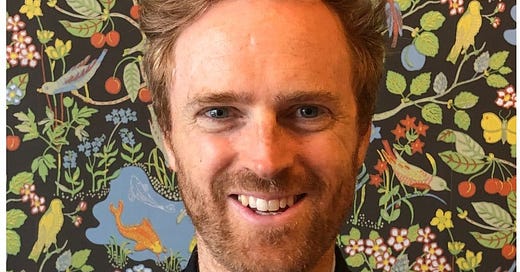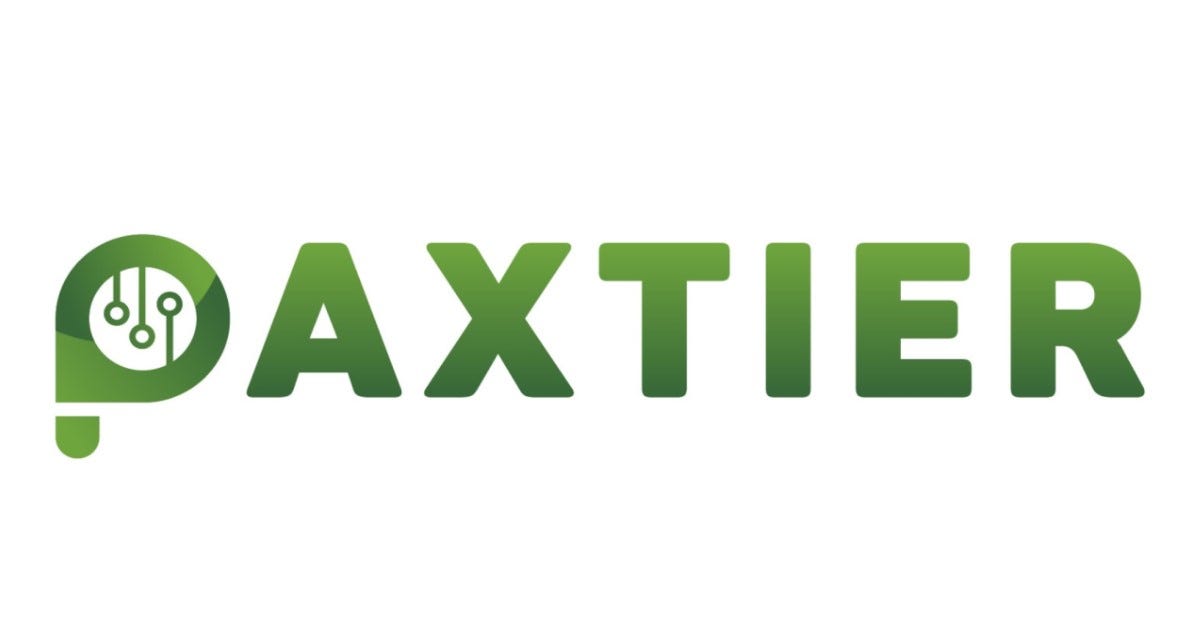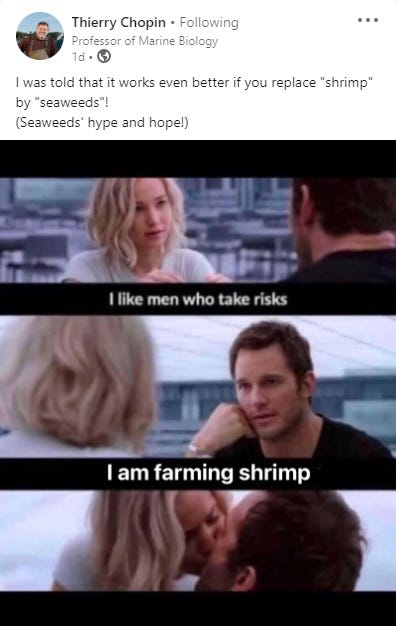🌊 Alaskan Seaweed and Green Chemistry with Macro Oceans.
PLUS Carbonwave raises $5 million, and microalgae from volcanic hot springs as a promising protein source for the future.
“We're focussed on creating a robust and sustainable business model that's not dependent on low seaweed prices to be viable." — Matthew Perkins, Macro Oceans
Dear algae technologists - hello and welcome to the Paxtier Report!
This week, check out Baikie et al.’s recent paper, which describes how a photosynthesis 'hack' could lead to new ways of generating renewable energy.
By studying photosynthesis in live cells at an ultrafast timescale - a millionth of a millionth of a second - Baikie et al. found a new electron transfer pathway. And here’s what project coordinator Dr Jenny Zhang had to say:
"Many scientists have tried to extract electrons from an earlier point in photosynthesis, but said it wasn't possible because the energy is so buried in the protein scaffold. The fact that we can steal them at an earlier process is mind-blowing. At first, we thought we'd made a mistake: it took a while for us to convince ourselves that we'd done it."
In today’s report:
Markets: 💸 Ocean Harvest Technology trades on the AIM.
Deals: 🤝 Carbonwave raises $5 million.
Movers and Shakers: 🌱 Alaskan Seaweed and Green Chemistry with Macro Oceans.
Around the web: 🌍 Venture capital discovers Indonesia’s $500M seaweed industry. Now comes the hard part.
Markets and Investing
✂️Algae Market Snippets
Some big moves in recent weeks:
Ocean Harvest Technology Group plc announces the admission of its entire issued ordinary share capital to trading on AIM ("AIM"). (Read more HERE).
Neste to begin production at its expanded Singapore plant. (Read more HERE).
Icelandic biotech secures $700K funding for algae production. (Read more HERE).
Research Nova Scotia puts $1.1 million into water surveillance. (Read more HERE).
Nestlé has entered into an agreement with the Pontificia Universidad Católica de Chile (UC Chile) to explore the potential of marine plants and other alternative vegetable protein sources in Latin America. (Read more HERE).
Israeli group joins forces with Morocco university for Sahara fish food project. Read more HERE).
Anpario moves from fish oil to microalgae with Optomega Algae. (Read more HERE).
Makers of Indian seaweed-based biostimulants demand higher standards for products. (Read more HERE).
Algae biofuel company Viridos raises $25M in Series A equity investment - led by Bill Gates' Breakthrough Energy Ventures, Chevron and United Airlines Ventures. (Read more HERE).
CH4 Global Launches Methane Tamer(TM) Beef Feedlot, first of the new formulations in the Methane Tamer(TM) line. (Read more HERE).
Carbonwave, which upcycles Sargassum seaweed from Mexico’s Caribbean coast into regenerative, advanced biomaterials, has announced an initial closing of a $5 million funding round. (Read more HERE).
Seafields, the sargassum farming company, has been given a Government grant of £250,000 to test its technology. (Read more HERE).
Simris upgrades its algae farm to double down on mission to replace fish-derived ingredients. (Read more HERE).
Rum and Sargassum, the biofuel company, is set to roll out a cost-saving gas venture. (Read more HERE).
Algaia acquired by JRS Group to meet ‘fast-growing’ demand for seaweed-based products. (Read more HERE).
Seventure enters negotiations with Cerea to acquire Polaris. (Read more HERE).
Chitose bio evolution has constructed a 5-hectare microalgae production facility called "CHITOSE Carbon Capture Central” in Sarawak, Malaysia. (Read more HERE).
Purina supports three-year research to explore the role of seaweed in regenerative agriculture. (Read more HERE).
Biesterfeld is taking over the distribution of Carbonwave's SeaBalance 2000 product for the DACH region, Poland and the Baltic States. (Read more HERE).
In depth with Peter Green
🌍 Alaskan Seaweed and Green Chemistry with Macro Oceans.
California-based seaweed biotech startup, Macro Oceans, has been making headlines thanks to the successful completion of the first phase of its pilot facility.
To gain further insight into Macro Oceans' technology and future plans, we had the privilege of sitting down with the company's CEO and founder, Matthew Perkins.
And in this interview, Matthew shares his thoughts on the start-up's progress, long-term goals, and the Alaskan seaweed industry.
Can you tell me more about Macro Oceans?
Macro Oceans sources its seaweed from Alaska and transforms it into low-carbon chemicals for use in materials, food, cosmetics, and many other applications.
At the heart of our technology is a multi-product, zero-waste system that offers a cost-effective approach to seaweed processing. By using innovative green chemistry, we preserve the unique bioactive compounds found in seaweed and can produce a range of high-quality plant-based chemicals and materials.
As the world transitions away from petroleum-based products and other high-carbon feedstocks such as field corn, we see seaweed as a lower-carbon alternative that offers promising solutions to some of the world's biggest challenges.
How’s progress with scaling?
We're thrilled to announce the completion of the first phase of our pilot facility. This milestone enables the scaling up of our lab process, which we've been refining for the past year, and paves the way for the first sales to customers with the help of our brand-new 12,500 sq ft facility.
We've also developed a stabilisation technique that allows us to preserve seaweed at room temperature for up to twelve months. This is a significant achievement because it eliminates the need for energy-intensive and expensive methods like freezing and drying that are typically used in the industry.
In addition, we're proud to disclose several launch partnerships. One of our partners is Sway, a California-based manufacturer of seaweed-derived packaging that has just won the Tom Ford Prize for plastic innovation. Our commitment to traceability, sustainability, and zero waste will help Sway create next-generation materials and systems. We are also producing bioactive ingredients for the cosmetics industry and have partnered with Oh Oh Organics and The Clean Beauty Chemist Aubri Thompson to commercialise these unique ingredients.
Finally, we're excited to reveal that we've raised a total of $5 million to date from top climate tech investors including Refactor Capital, Lowercarbon Capital, and McKinley Capital, as well as from a group of strategic angel investors.
What else have you been working on?
We're currently making significant progress in establishing a robust supply chain, with a sharp focus on Alaska. Our efforts are concentrated on identifying potential growers and partners, and strategizing on how to collaborate with them. It goes without saying that we have no intention of processing all our seaweed in Sacramento or California. As much as 90% of seaweed comprises water, making it impractical to transport over long distances. Consequently, our plans include the establishment of an Alaska-based operation, and we've already made considerable headway in developing a comprehensive blueprint that we'll be announcing later this year.
Overall, our model involves purchasing seaweed at prices that farmers can afford to sell at today. We've analysed different scenarios and incorporated relevant parameters to develop a viable and scalable model around this. And we've successfully implemented this model on a pilot scale - continually refining it as we scale up our operations.
Ultimately, we're focussed on creating a robust and sustainable business model that's not dependent on low seaweed prices to be viable. We believe in staying grounded and pragmatic, avoiding unrealistic assumptions about our customers' willingness to pay high prices for our products.
Why Alaska?
Alaska is a great place to grow seaweed because of its extensive coastline, established fishing industry, existing infrastructure, and support from the state government. The government is not only investing in the industry but also taking a thoughtful approach to managing the natural resources to avoid overexploitation. The state is very conscious about their fisheries, nutrient flows, and any potential conflicts which may arise from scaling the seaweed industry. There's so much potential here.
What’s next for Macro Oceans?
Our top priority is to meet all our milestones and ensure that we can supply material to the biorefinery at a competitive price point in the future.
In terms of our team, we currently have five dedicated full-time employees, mostly scientists and engineers. And soon, we plan to open up additional positions focused on engineering and science, as well as more commercial roles. We are intent on building a high-performing, lean team that can effectively execute our mission.
Ultimately, at Macro Oceans we are primarily focused on processing seaweed. We do not grow seaweed ourselves, but instead purchase it from seaweed farmers. And while we don't produce downstream applications or consumer products, we do provide the essential raw materials and ingredients needed to make them. We're always open to hearing from individuals or companies interested in selling seaweed or buying seaweed-based ingredients. If there is a potential for collaboration, we're happy to discuss further and explore mutually beneficial opportunities.
If you’d like to learn more about Macro Oceans, check out this recent post by the team. You can also connect with Matthew on LinkedIn here and see the Macro Oceans website here.
🐦Tweet of the week
🔥 What else was hot in algae tech?
(Paper) Algal enzyme fed just the right diet churns out green fuel. (Read more HERE).
Upwell Cosmetics brings algae-derived wax to beauty (Read more HERE).
Provectus Algae has announced that Steven F. Schnittger has joined the company as a cosmetics industry advisor. (Read more HERE).
Venture capital discovers Indonesia’s $500M seaweed industry. Now comes the hard part. (Read more HERE).
Savoring seaweed: Kombu attracts US chefs with unique umami taste, veggie boom. (HERE).
Microalgae from volcanic hot springs as a promising protein source for the future. (Read more HERE).
(Paper) Light-independent regulation of algal photoprotection by CO2 availability. (Read more HERE).
Microplastics affect the ability of algae to produce energy. (Read more HERE).
GC Rieber on future of omega-3: Fish and algae go hand-in-hand. (Read more HERE).
West Vancouver lab aims to restore world's lost kelp forests. (Read more HERE).
Can submersible seaweed platforms help regenerate ecosystems and provide economic returns? (Read more HERE).
That’s all folks!
Thanks again for joining us this week. Hope you have a great day and stay tuned for more algae tech updates soon!
Peter








